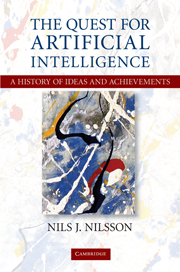Book contents
- Frontmatter
- Contents
- Preface
- PART I BEGINNINGS
- PART II EARLY EXPLORATIONS: 1950S AND 1960S
- PART III EFFLORESCENCE: MID-1960S TO MID-1970S
- PART IV APPLICATIONS AND SPECIALIZATIONS: 1970s TO EARLY 1980s
- PART V “NEW-GENERATION” PROJECT
- 22 The Japanese Create a Stir
- 23 DARPA's Strategic Computing Program
- PART VI ENTR'ACTE
- PART VII THE GROWING ARMAMENTARIUM: FROM THE 1980s ONWARD
- PART VIII MODERN AI: TODAY AND TOMORROW
- Index
- Plate section
22 - The Japanese Create a Stir
Published online by Cambridge University Press: 05 August 2013
- Frontmatter
- Contents
- Preface
- PART I BEGINNINGS
- PART II EARLY EXPLORATIONS: 1950S AND 1960S
- PART III EFFLORESCENCE: MID-1960S TO MID-1970S
- PART IV APPLICATIONS AND SPECIALIZATIONS: 1970s TO EARLY 1980s
- PART V “NEW-GENERATION” PROJECT
- 22 The Japanese Create a Stir
- 23 DARPA's Strategic Computing Program
- PART VI ENTR'ACTE
- PART VII THE GROWING ARMAMENTARIUM: FROM THE 1980s ONWARD
- PART VIII MODERN AI: TODAY AND TOMORROW
- Index
- Plate section
Summary
The Fifth-Generation Computer Systems Project
In 1982, Japan's Ministry of International Trade and Industry (MITI) launched a joint government and industry project to developwhat they called “Fifth Generation Computer Systems” (FGCS). Its goal was to produce computers that could perform AI-style inferences from large data and knowledge bases and communicate with humans using natural language. As one of the reports about the project put it, “These systems are expected to have advanced capabilities of judgement based on inference and knowledge-base functions, and capabilities of flexible interaction through an intelligent interface function.”
The phrase “Fifth Generation” was meant to emphasize dramatic progress beyond previous “generations” of computer technology. The first generation, developed during and after World War II, used vacuum tubes. Around 1959, transistors replaced vacuum tubes – giving rise to the second generation – although the transistors, like the vacuum tubes before them, were still connected to each other and to other circuit components using copperwires. During the 1960s, transistors and other components were fabricated on single silicon wafer “chips,” and the several chips comprising a computer were connected together by wires. Computers using this so-called smallscale integration (SSI) technology comprised the third generation. In the late 1970s, entire microprocessors could be put on a single chip using “very large-scale integration” (VLSI) technology – the fourth generation. The Japanese fifth generation, besides its sophisticated software, was to involve many parallel processors using “ultra large-scale integration” (ULSI).
MITI planned to develop a prototype machine, in the form of what computer scientists were beginning to call a “workstation,” which was to consist of several processors running in parallel and accessing multiple data and knowledge bases.
- Type
- Chapter
- Information
- The Quest for Artificial Intelligence , pp. 277 - 285Publisher: Cambridge University PressPrint publication year: 2009



